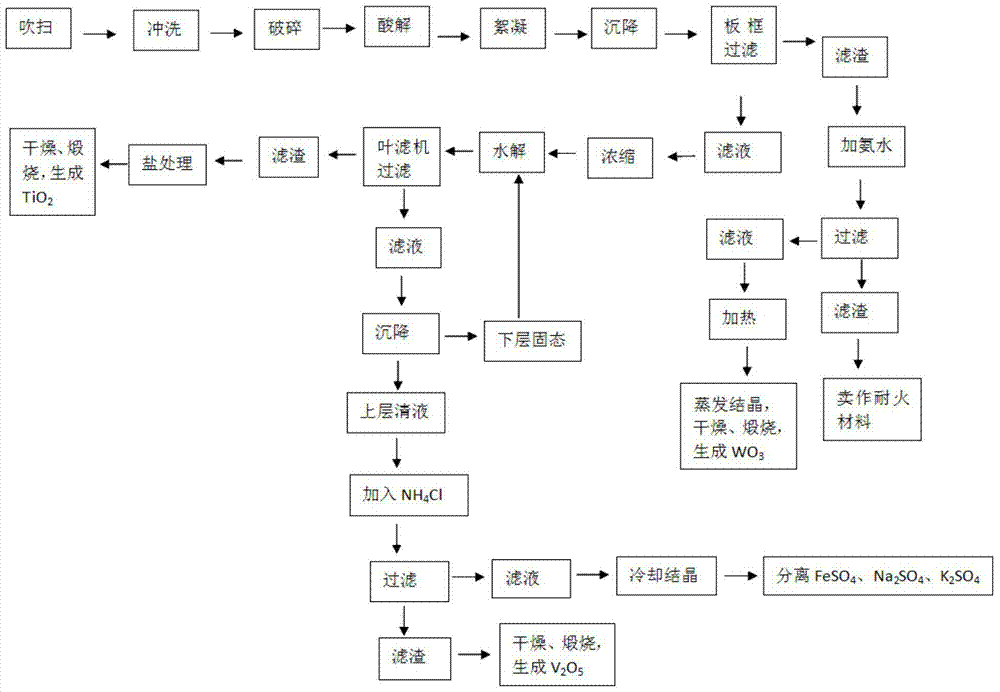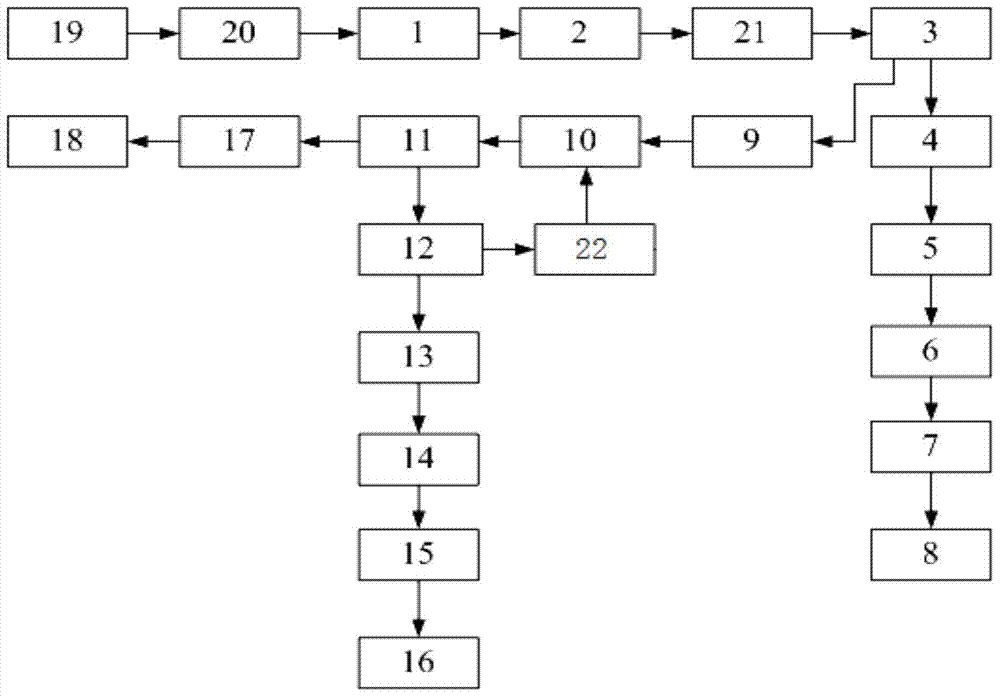A method and device for recovering metal oxides from waste flue gas denitrification catalyst
A denitrification catalyst and waste flue gas technology, applied in the direction of alkali metal compounds, titanium oxide/hydroxide, chemical instruments and methods, etc., can solve the problems of high consumption of raw materials, low extraction purity, complicated operation, etc., and improve the utilization rate Effect
- Summary
- Abstract
- Description
- Claims
- Application Information
AI Technical Summary
Problems solved by technology
Method used
Image
Examples
Embodiment 1
[0052] Embodiment 1 of the present invention: a method for recovering metal oxides from waste flue gas denitrification catalysts, such as figure 1 shown, including the following steps:
[0053] S01, blow the waste flue gas denitrification catalyst with compressed air for 20-23 minutes for each module to remove the dust in the channel;
[0054] S02, rinse the catalyst after dust removal with a high-pressure water gun, and rinse each module for 15-20 minutes, with a pressure of 8-12Mpa, to further remove the dust in the channel;
[0055] S03, drying the washed catalyst;
[0056] S1, pulverizing the catalyst and adding concentrated sulfuric acid for acidolysis, adding water after acidolysis to obtain a titanyl sulfate solution; specifically including the following steps:
[0057] S11, crushing the catalyst into catalyst powder of 160-180 mesh;
[0058] S12, put the catalyst powder into a lead-made acidolysis tank, add 88%-90% concentrated sulfuric acid according to the weight ...
Embodiment 2
[0071] Embodiment 2: a kind of method that recovers metal oxide from waste flue gas denitrification catalyst, such as figure 1 shown, including the following steps:
[0072] S01, blow the waste flue gas denitrification catalyst with compressed air, and blow each module for 15-20 minutes to remove the dust in the channel;
[0073] S02, rinse the catalyst after dust removal with a high-pressure water gun, and rinse each module for 20-25 minutes, with a pressure of 5-8Mpa, to further remove the dust in the channel;
[0074] S03, drying the washed catalyst;
[0075] S1, pulverizing the catalyst and adding concentrated sulfuric acid for acidolysis, adding water after acidolysis to obtain a titanyl sulfate solution; specifically including the following steps:
[0076] S11, crushing the catalyst into 180-200 mesh catalyst powder;
[0077] S12, put the catalyst powder into a lead-made acidolysis tank, add 85% to 88% concentrated sulfuric acid according to the weight ratio of cataly...
Embodiment 3
[0090] Embodiment 3: A method for recovering metal oxides from waste flue gas denitrification catalysts, such as figure 1 shown, including the following steps:
[0091] S01, blow the waste flue gas denitrification catalyst with compressed air for 23 to 30 minutes for each module to remove the dust in the tunnel;
[0092] S02, rinse the catalyst after dust removal with a high-pressure water gun, and rinse each module for 25 to 30 minutes, with a pressure of 7 to 10Mpa, to further remove the dust in the channel;
[0093] S03, drying the washed catalyst;
[0094] S1, pulverizing the catalyst and adding concentrated sulfuric acid for acidolysis, adding water after acidolysis to obtain a titanyl sulfate solution; specifically including the following steps:
[0095] S11, pulverizing the catalyst into 190 mesh catalyst powder;
[0096] S12, put the catalyst powder into a lead-made acidolysis tank, add 90% to 92% concentrated sulfuric acid according to the weight ratio of catalyst ...
PUM
| Property | Measurement | Unit |
|---|---|---|
| recovery rate | aaaaa | aaaaa |
| recovery rate | aaaaa | aaaaa |
Abstract
Description
Claims
Application Information
 Login to View More
Login to View More - R&D
- Intellectual Property
- Life Sciences
- Materials
- Tech Scout
- Unparalleled Data Quality
- Higher Quality Content
- 60% Fewer Hallucinations
Browse by: Latest US Patents, China's latest patents, Technical Efficacy Thesaurus, Application Domain, Technology Topic, Popular Technical Reports.
© 2025 PatSnap. All rights reserved.Legal|Privacy policy|Modern Slavery Act Transparency Statement|Sitemap|About US| Contact US: help@patsnap.com


